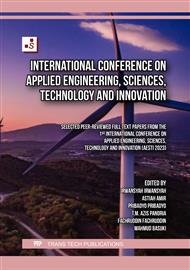[1]
M. J. B. Kabeyi and O. A. Olanrewaju, "Sustainable energy transition for renewable and low carbon grid electricity generation and supply," Front. Energy Res., vol. 9, p.1032, 2022.
DOI: 10.3389/fenrg.2021.743114
Google Scholar
[2]
M. S. Nur and J. Jusri, "Biomassa bahan baku dan teknologi konversi untuk energi terbarukan (kajian pustaka dan gagasan aplikasi di indonesia)," PT Insa. Fajar Mandiri Nusantara. Bogor, 2014.
DOI: 10.55981/brin.709
Google Scholar
[3]
A.S.R.H.Y.S.R.S.H. Vidia, Buku Panduan Konversi POME Menjadi Biogas Pengembangan Proyek di Indonesia. 2015.
Google Scholar
[4]
W. Y. Irwansyah, "Potensi Pemanfaatan Palm Oil Mill Effluent (POME) Sebagai Bahan Baku Pembangkit Listrik Tenaga Biogas (PLTBg) Di PKS PT. Fajar Saudara Kusuma," J. Tek. Elektro Univ. Tanjungpura, vol. 2, no. 1, 2016.
DOI: 10.31849/sainetin.v1i1.166
Google Scholar
[5]
P.G.P. B. D. LESTARI, Ringkasan Eksekutif. 2020.
Google Scholar
[6]
J.S. Setyono, F. H. Mardiansjah, and M. F. K. Astuti, "Potensi Pengembangan Energi Baru dan Energi Terbarukan di Kota Semarang," J. Riptek, vol. 13, no. 2, p.177–186, 2019.
DOI: 10.14710/jebt.2022.13395
Google Scholar
[7]
P.L. and T. Thorium, Pembangkit Listrik Tenaga Thorium. 2021.
Google Scholar
[8]
W.S. Winanti, P. Prasetiyadi, and W. Wiharja, "Pengolahan Palm Oil Mill Effluent (POME) menjadi biogas dengan sistem anaerobik tipe Fixed Bed tanpa proses netralisasi," J. Teknol. Lingkung. Vol, vol. 20, no. 1, 2019.
DOI: 10.29122/jtl.v20i1.3248
Google Scholar
[9]
S.S. Raman, Z.Z. Noor, S.S. Syed Narolhisa, C.S. Chong, and L.C. Stringer, "Energy generation from palm oil mill effluent (POME): the environmental impact perspective," Chem. Eng. Trans., vol. 72, p.25–30, 2019.
Google Scholar
[10]
A. Sodri and F. E. Septriana, "Biogas Power Generation from Palm oil mill effluent (POME): Techno-economic and environmental impact evaluation," Energies, vol. 15, no. 19, p.7265, 2022.
DOI: 10.3390/en15197265
Google Scholar
[11]
T. A. Rizal, M. Mahidin, and M. Ayyub, "Pengembangan Anaerobic Digester Untuk Produksi Biogas Dari Limbah Cair Pabrik Kelapa Sawit," JURUTERA-Jurnal Umum Tek. Terap., vol. 2, no. 02, p.8–27, 2015.
Google Scholar
[12]
O. J. K. (OJK) Indonesia, "Pembiayaan Pembangkit Listrik Tenaga Biogas," Usaid, 2016.
Google Scholar
[13]
S. Kanata, "Pembangkitan Ekonomis pada Unit Pembangkit Listrik Tenaga Diesel Telaga Gorontalo Menggunakan Algoritma Genetika," J. Rekayasa Elektr., vol. 13, no. 3, p.119–124, 2017.
DOI: 10.17529/jre.v13i3.5451
Google Scholar
[14]
N. Fitria, S. Suprihardi, and F. Fauzi, "OPTIMASI OPERASI PEMBANGKIT LISTRIK TENAGA MESIN GAS (PLTMG) ARUN DENGAN SISTEM HOMER ENERGI," J. TEKTRO, vol. 5, no. 1, 2021.
Google Scholar
[15]
H. Energy, "Homer pro version 3.7 user manual," HOMER Energy Boulder, CO, USA, vol. 7, 2016.
Google Scholar
[16]
A. Hasibuan, M. Daud, R. Kurniawan, W. V. Siregar, P. A. Safna, and others, "Comparison Analysis Of Electricity Use By State Electricity Company With Renewable Energy Sources In Household Type 54," in 2022 6th International Conference on Electrical, Telecommunication and Computer Engineering (ELTICOM), 2022, p.24–29.
DOI: 10.1109/elticom57747.2022.10037828
Google Scholar
[17]
A. Hasibuan, W. V. Siregar, M. Isa, E. Warman, R. Finata, and M. Mursalin, "The Use of Regression Method on Simple E for Estimating Electrical Energy Consumption," HighTech Innov. J., vol. 3, no. 3, p.306–318, 2022.
DOI: 10.28991/hij-sp2022-03-06
Google Scholar
[18]
A. Hasibuan, M. Daud, M. Sayuti, F. Hidayatullah, W. V. Siregar, and R. Fachroji, "Utilization of Small Wind Turbines as Source Alternative Electrical Energy for Lighting in the Banyak Island Tourism Area, Aceh Singkil, Indonesia," in 2022 6th International Conference on Electrical, Telecommunication and Computer Engineering (ELTICOM), 2022, p.44–47.
DOI: 10.1109/elticom57747.2022.10037795
Google Scholar
[19]
A. Hasibuan, M. Isa, M. I. Yusoff, S. R. A. Rahim, and I. Nrartha, "Effect of installation of distributed generation at different points in the distribution system on voltage drops and power losses," in AIP Conference Proceedings, 2021, vol. 2339, no. 1.
DOI: 10.1063/5.0044192
Google Scholar
[20]
M. Gozan, N. Aulawy, S. F. Rahman, and R. Budiarto, "Techno-economic analysis of biogas power plant from POME (palm oil mill effluent)," Int. J. Appl. Eng. Res., vol. 13, no. 8, p.6151–6157, 2018.
Google Scholar
[21]
M. N. Dewi, "Economic Feasibility Study Biogas Power Plant at 80 Ton/Hour Palm Oil Mill," JournalNX-A Multidiscip. Peer Rev. J., vol. 6, no. 8, 2020.
Google Scholar


